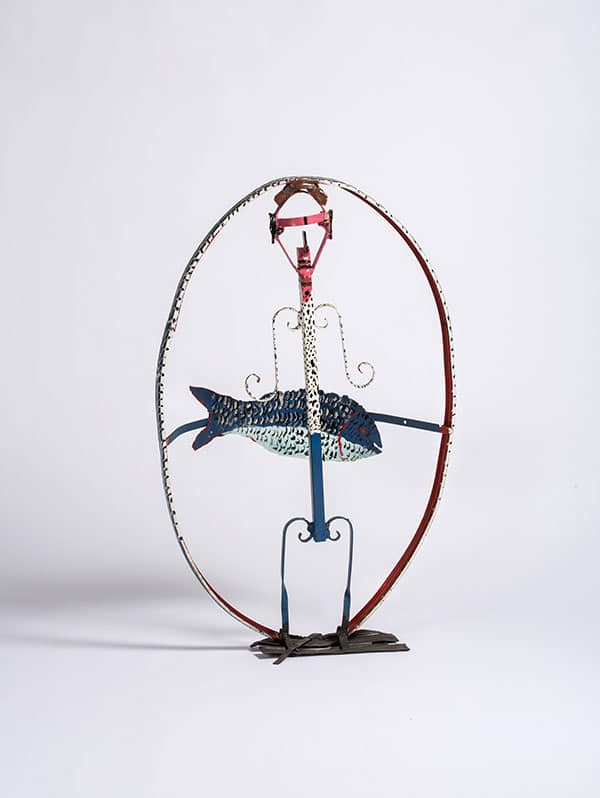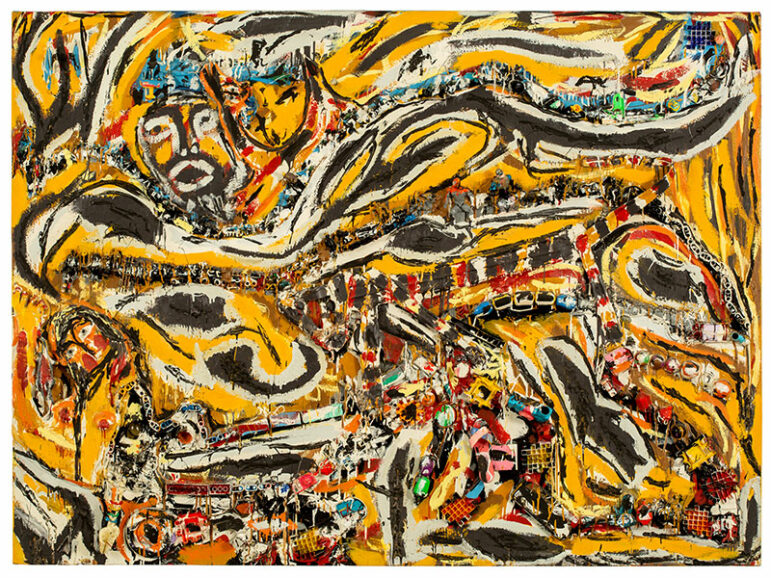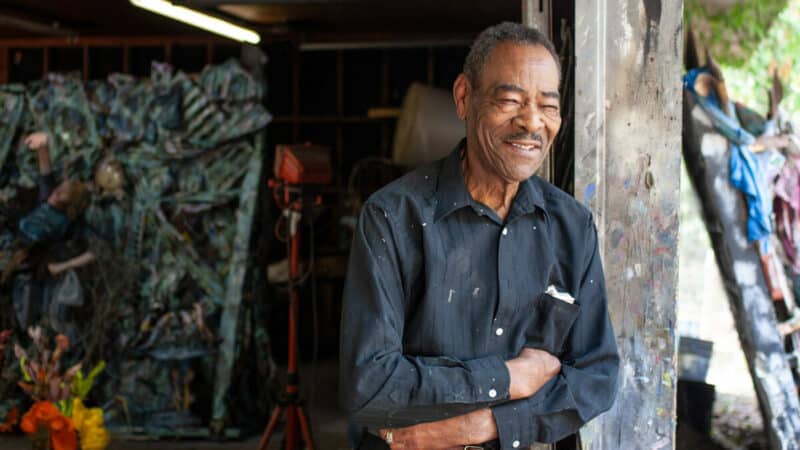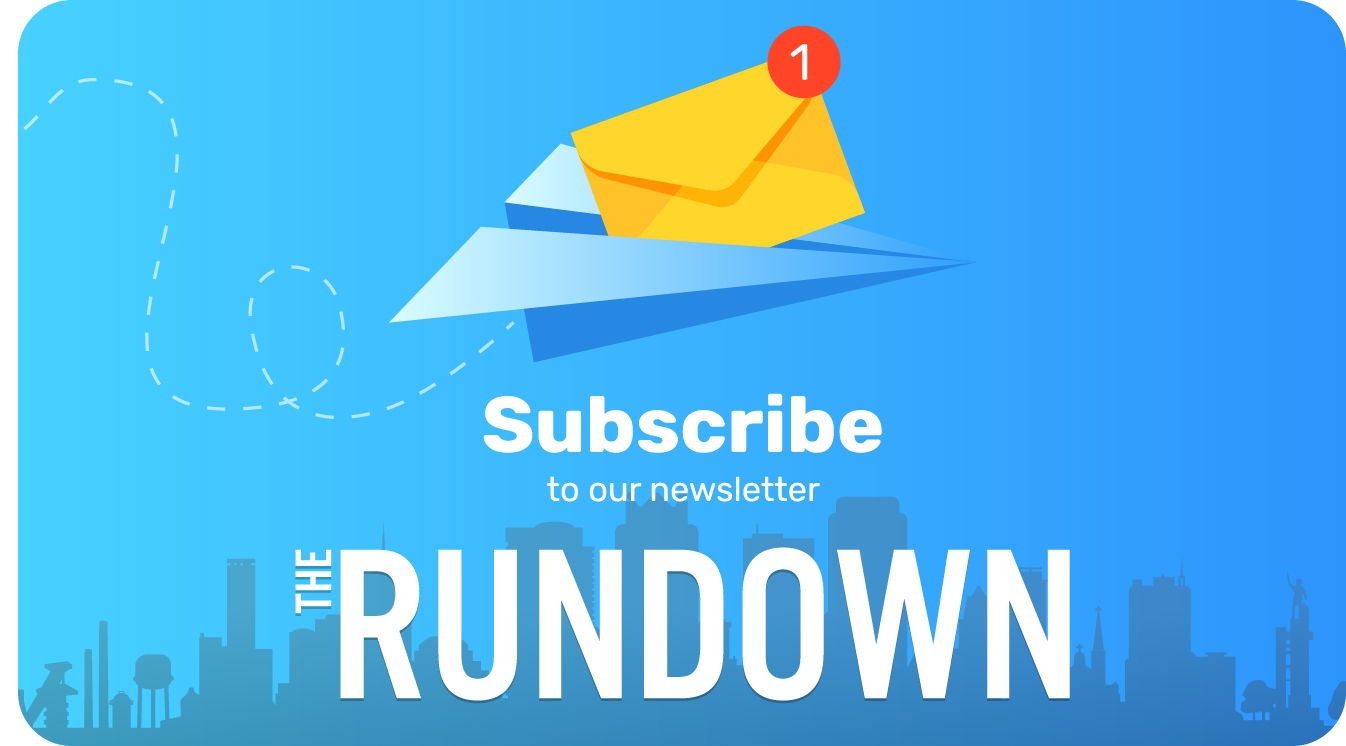Late Alabama artist Thornton Dial honored with first full-scale retrospective in his home state
By Rachel Parker, WBHM Reflect Alabama Fellow
As a child, Richard Dial can remember hearing his mother on the phone at two or three in the morning with their neighbor, asking him to try and get his father, Thornton Dial, to come inside from the backyard workshop after her own failed attempts. He was still busy creating art.
“Art was a part of his life,” Richard Dial said. “I think he really found his niche in life, his purpose in life,” Richard says.
Some of Thornton Dial’s pieces eventually made it into the nation’s top museums, including the Metropolitan Museum of Art in New York. But recognition of the Alabama-born artist by the larger art world did not come through a traditional path. Dial, who died in 2016, had little formal education and no art training.
Now, the University of Alabama at Birmingham’s Abroms-Engle Institute for the Visual Arts presents the first retrospective of Dial’s work in his home state. The exhibit, Thornton Dial: I, Too, Am Alabama, is open through Saturday.

One of the many jobs Dial worked throughout his life was as a metalworker at the Pullman Standard Plant in Bessemer, AL. From his different jobs, he sharpened his artistic skills and used materials he worked with daily, such as rope, wires, metal and fishing lures, to make art.
“I think that is a classic, prime example of some of his best works,” said Brandon Dial, Thornton Dial’s grandson. “When you’re taking things that people consider to be scraps and you’re turning it into something that is truly a treasure.”
In his popular piece called, “How Things Work: The Parade of Life,” two female figures made up of swirling colors – red, orange, black, yellow and white – spread across the canvas. Look closer and there’s a “parade” of children’s toys – cars and legos – lined up and attached to the painting. The objects appear to move through and around the women’s bodies.

“That’s the power of Mr. Dial’s work is that there is a lot of depth to it. There’s a lot of meaning behind it. Sometimes you can add your own meaning. Sometimes you know what his meaning is. It’s not just what the face value is like, what you see initially,” AEIVA Assistant Curator Tina Ruggieri said.
A rose and women were recurring symbols for Dial. They represent his relationship to the women in his life, since he was raised by his grandmother and aunts.
Dial’s artwork also reflects real world, complicated topics including politics, race, class and the environment.
“He would go to work, come home and eat. And he would always, always, every day, he would stop and watch the news. So he knew what was going on in the world,” Richard Dial said.
A timeline made up of plaques in the exhibit connects Dial’s life to contemporary historical events. For instance, the birth of his first child in 1953 is followed by the lynching of Emmett Till in 1955.
Dial wanted his art to be a force for change. He said to make that happen we should focus on the “little man,” which he described as people in the minority and lower class who are often forgotten, and their ideas.
“I see a lot of optimism in a lot of Thornton Dial’s work, even when he’s dealing with very difficult subject matter,.” said Paul Barrett, curator of the UAB exhibit.
While Dial gained widespread acclaim, Barrett says a show like this in Alabama is overdue.
“The fact that Thornton Dial’s work was not just recognized but celebrated in museums in New Orleans and Atlanta for many years before he was celebrated in his hometown, I think was a historic injustice that we were very happy to address,” Barrett said.
The University of Alabama at Birmingham holds WBHM’s broadcast license, but our news and businesses department operate independently.
Editor’s note: Story updated to attribute quote to AEIVA Assistant Curator Tina Ruggieri
40 years after ‘Purple Rain,’ Prince’s band remembers how the movie came together
Before social media, the film Purple Rain gave audiences a peak into Prince’s musical life. Band members say the true genesis of the title song was much less combative than the version presented in the film.
Park Fire in California could continue growing exponentially, Cal Fire officer says
Cal Fire has confirmed that over a hundred structures have been damaged in the Park Fire, which grew overnight near Chico, Calif. Difficult firefighting conditions are forecast through Friday night.
Checking in with Black voters in Georgia about the election, now that Biden is out
Some voters who could be key to deciding who wins Georgia. What do they think about Vice President Harris becoming the frontrunner in the race to be the Democratic nominee?
Tahiti’s waves are a matter of ‘life and death’ for surfing Olympics
Tahiti's Teahupo'o wave has a slew of riders for the Paris 2024 Olympics. NPR finds out why it's called one of the most dangerous waves.
Researchers are revising botanical names to address troubling connotations
Since the mid-1700s, researchers have classified life with scientific names. But some of them have problematic histories and connotations. The botanical community is trying to tackle this issue.
A spectacular opening ceremony wowed a global audience despite Paris’ on-and-off rain
The Paris Olympics opening ceremony wowed Parisians, fans and most everyone who was able to catch a glimpse of thousands of athletes floating down the Seine to officially begin the Games.



